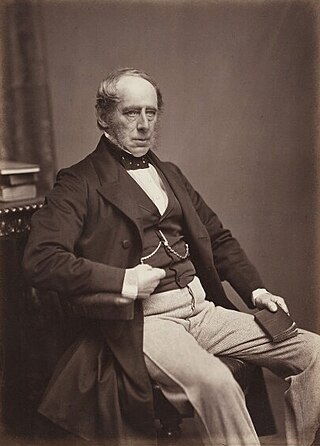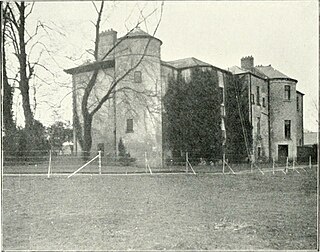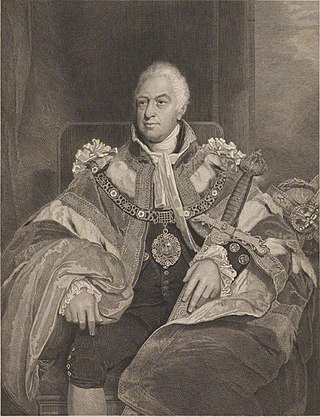Related Research Articles

Earl of Chesterfield, in the County of Derby, was a title in the Peerage of England. It was created in 1628 for Philip Stanhope, 1st Baron Stanhope. He had been created Baron Stanhope, of Shelford in the County of Nottingham, in 1616, also in the Peerage of England. Stanhope's youngest son, the Hon. Alexander Stanhope, was the father of James Stanhope, 1st Earl Stanhope, while his half-brother Sir John Stanhope of Elvaston was the great-grandfather of William Stanhope, 1st Earl of Harrington.

John Somerset Pakington, 1st Baron Hampton,, known as Sir John Pakington, Bt, from 1846 to 1874, was a British Conservative politician.

Earl of Lonsdale is a title that has been created twice in British history, firstly in the Peerage of Great Britain in 1784, and then in the Peerage of the United Kingdom in 1807, both times for members of the Lowther family.

Admiral Sir Compton Edward Domvile, was a distinguished Royal Navy officer in the Edwardian and Victorian eras.
There have been four baronetcies created for persons with the surname Dundas, one in the Baronetage of Great Britain and three in the Baronetage of the United Kingdom. One creation is extant as of 2008.
The Poë, later Poë-Domvile Baronetcy, of Heywood in the Parish of Ballinakill in Queen's County, was a title in the Baronetage of the United Kingdom. It was created on 2 July 1912 for Hutcheson Poë, subsequently Lord Lieutenant of Queen's County (1920–22) and a Senator of the Irish Free State (1922–24). He married Mary Adelaide, only surviving daughter of Sir William Compton Domvile, 3rd Baronet. Through this marriage Heywood House came into the Poë family.
The Sheriff of County Dublin was the Sovereign's judicial representative in County Dublin. Initially, an office for a lifetime, assigned by the Sovereign, the Sheriff became an annual appointment following the Provisions of Oxford in 1258. The first recorded Sheriff was Ralph Eure, appointed in that year. The next recorded Sheriff was Sir David de Offington, who was Sheriff in 1282. Besides his judicial importance, the sheriff had ceremonial and administrative functions and executed High Court Writs.
Domvile baronets may refer to:
William Domville (1609–1689) was a leading Irish politician, barrister and Constitutional writer of the Restoration era. Due to the great trust which the English Crown had in him, he served as Attorney General for Ireland throughout the reign of Charles II (1660-1685) and also served briefly in the following reign. It was during his term of office that the Attorney General emerged as the pre-eminent legal adviser to the Crown in Ireland.
Domvile is a surname. Notable people with the surname include:
Domville may refer to:

The Domvile Baronetcy, of Templeogue in the County of Dublin, was created in the Baronetage of Ireland on 21 December 1686 for Thomas Domvile, who represented Mullingar in the Irish House of Commons. He was the son of William Domville, son of Gilbert Domville, MP for Dublin, member of an ancient Cheshire family. The second Baronet was a member of the Irish Parliament for County Dublin. The title became extinct on his death in 1768. Sir William Domvile, brother of the first Baronet, represented Armagh and Dublin in the Irish Parliament. William Domville, elder brother of the aforementioned Gilbert Domvile, was the ancestor of the Domville baronets of St Alban's.
The Domvile Baronetcy, of Templeogue and Santry House in the County of Dublin, was created in the Baronetage of the United Kingdom on 22 May 1815 for Compton Domvile, subsequently Member of Parliament for Bossiney, Okehampton and Plympton Erle. He was the son of Charles Pocklington, nephew and heir of the second and last Domvile baronet of the 1686 creation. Charles Pocklington had assumed by royal licence the surname of Domvile in lieu of Pocklington in 1768 on succeeding to the estates of his uncle. The title became extinct on the death of the fourth Baronet in 1935.

Sir William Domville, 1st Baronet was Lord Mayor of London for 1813–14.
The Clerk of the Crown and Hanaper was a civil servant within the Irish Chancery in the Dublin Castle administration. His duties corresponded to the offices of Clerk of the Crown and Clerk of the Hanaper in the English Chancery. Latterly, the office's most important functions were to issue writs of election to the Westminster Parliament, both for the House of Commons and for Irish representative peers in the House of Lords.
Sir Compton Domvile, 1st Baronet of Templeogue and Santry House, County Dublin, was an Irish Member of Parliament in the United Kingdom parliament and Governor of County Dublin.
Lady Margaret Frances Domville was an Irish aristocrat and a writer. She was also the daughter of the 3rd Earl of Howth and the wife of Sir Charles Compton Domville, 2nd Bt.

Santry Court was a Georgian house and demesne in Santry, north County Dublin built between 1703-09 on the site of an earlier medieval residence.
Sir Thomas Domvile, 1st Baronet was an Anglo-Irish politician.